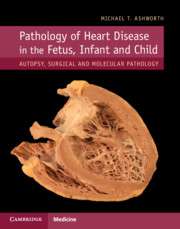Book contents
- Pathology of Heart Disease in the Fetus, Infant and Child
- Pathology of Heart Disease in the Fetus, Infant and Child
- Copyright page
- Dedication
- Contents
- Preface
- Chapter 1 The Anatomy of the Normal Heart
- Chapter 2 Examination of the Heart
- Chapter 3 Development of the Heart
- Chapter 4 Congenital Heart Disease (I)
- Chapter 5 Congenital Heart Disease (II)
- Chapter 6 Ischaemia and Infarction
- Chapter 7 Cardiomyopathy
- Chapter 8 Inflammation of the Myocardium, Endocardium and Aorta
- Chapter 9 The Coronary Arteries
- Chapter 10 Metabolic and Storage Disease
- Chapter 11 Pericardium
- Chapter 12 Fetal Cardiovascular Disease
- Chapter 13 Tumours
- Chapter 14 Heart Transplantation
- Chapter 15 Sudden Cardiac Death in the Young
- Index
- References
Chapter 10 - Metabolic and Storage Disease
Published online by Cambridge University Press: 19 August 2019
- Pathology of Heart Disease in the Fetus, Infant and Child
- Pathology of Heart Disease in the Fetus, Infant and Child
- Copyright page
- Dedication
- Contents
- Preface
- Chapter 1 The Anatomy of the Normal Heart
- Chapter 2 Examination of the Heart
- Chapter 3 Development of the Heart
- Chapter 4 Congenital Heart Disease (I)
- Chapter 5 Congenital Heart Disease (II)
- Chapter 6 Ischaemia and Infarction
- Chapter 7 Cardiomyopathy
- Chapter 8 Inflammation of the Myocardium, Endocardium and Aorta
- Chapter 9 The Coronary Arteries
- Chapter 10 Metabolic and Storage Disease
- Chapter 11 Pericardium
- Chapter 12 Fetal Cardiovascular Disease
- Chapter 13 Tumours
- Chapter 14 Heart Transplantation
- Chapter 15 Sudden Cardiac Death in the Young
- Index
- References
Summary
This chapter deals with the inherited metabolic diseases affecting the heart in which there are morphological changes sufficient to permit a tentative diagnosis to be offered by a pathologist. A large first section deals with glycogen storage disorders and is well illustrated. This is followed by discussion of lysosomal storage disorders, including Niemann–Pick disease, sections on mucopolysaccharidosis and of the commoner disorders of lipid oxidation. Disorders of iron metabolism and amino acidurias close the chapter.
- Type
- Chapter
- Information
- Pathology of Heart Disease in the Fetus, Infant and ChildAutopsy, Surgical and Molecular Pathology, pp. 221 - 242Publisher: Cambridge University PressPrint publication year: 2019



